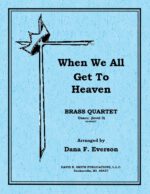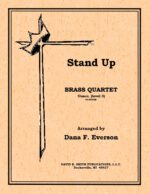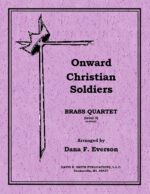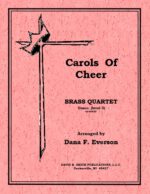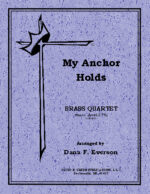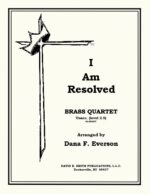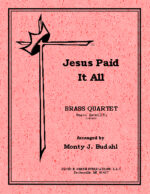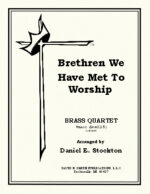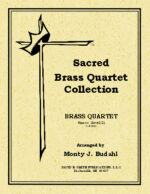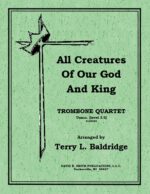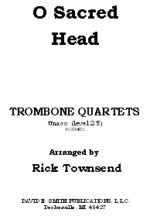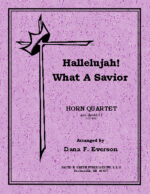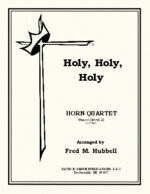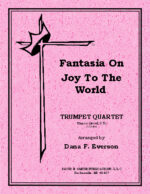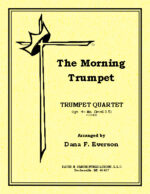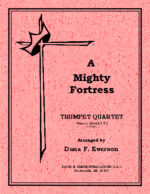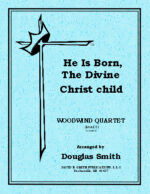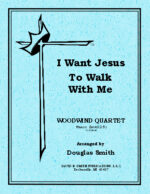-
When We All Get To Heaven
$7.00Scored for two trumpets and two trombones with opt. Horn for Trom. 1 and Bar. TC for Trom. 2. The opening begins excitedly while giving a sense of moving upward. The first presentation of the theme is very much in a march style and then breaks into more activity with rhythmic alterations. The second section moves to a new key and is essentially a trombone duet and then adds upper voices to place the piece on an elevated plain. Another modulation moves the musical thought even higher while passing the melodic motifs around to the different voices. The Coda gives a sense of elevation and arrival.
-
Stand Up
$8.00A brass quintet with opt. horn and BHTC parts. After a rousing introduction the piece goes into a straight forward rendition of “Stand Up For Jesus” with the melody in trumpet one with various rhythmic devices in the other parts. After a brief transition a modulation occurs presenting “Stand Up, Stand Up For Jesus” again the melodic material is passed around amongst the parts. After another transition and modulation the piece reverts back to the first tune where it becomes more rhythmically active up to a fiery conclusion.
-
Onward Christian Soldiers
$9.00An accompanied brass quartet for two trumpets with opt. horn and BHTC with piano. The opening is a fanfare with resolve. The first rendition of the tune is passed between parts in a somewhat hocket fashion where it continues throughout. The second section is more chordal with the accompaniment more march and fanfare like. Then a brief transition in the piano only is joined by the brass in a cascading series of entrances. Then the brass join the piano in a Q/A transition leading into a choral presentation of the theme. After a motivic interplay of the brass the piece concludes in an augmented statement in the brass.
-
Carols Of Cheer
$8.00A Christmas brass quartet score for two trumpets, horn and trombone with optional parts for Flugel horn (horn) and bartione (trombone) in a medley format includes “Fum Fum Fum,” “Come Here Little Children,” ” Ding Dong Merrily On High” that bubbles with delight from beginning to end. With multiple key transitions and color shifts this medley will add delight and cheer to this festive time of the year.
-
My Anchor Holds
$8.00A brass quartet that begins with delightful counterpoint and then breaks into the tune in the trombone with a horn counterline which in turn is punctuated with the trumpet lines. The middle section opens with the horn offset by the other voices and then the melodic material is passed around among all voices. The final section becomes even more active and ends with a solid resolve. (Opt parts Trp for horn and Bar. TC for trombone.)
-
God Leads His Dear Children Along
$8.00Written in a gentle and flowing manner, this brass quartet is scored for two trumpets, horn, trombone, and piano. It is written with very open voicing, giving each part a chance to express.
-
-
Jesus Paid It All
$7.00A brass quartet scored for two trumpets and two trombones with optional horn and baritone parts. The piece is in some ways simplistic and at the same time quite profound. The first section is somewhat gentle with subtle countrapuntal movement. The second section is more declamatory and then comes to a quiet repose.
-
Come Thou Fount
$7.00A brass quartet for two trumpets and two trombones with opt. Fr. Horn and Baritone Treble Clef. It begins in unison and then breaks into four part harmony- all in a majestic style, continuing in that manner throughout the first verse. The second verse is a duet between the first trumpet and trombone. The next statement passes the tune around the various parts gaining in excitement. The final section is more solemn and then enhanced with bell-tone figures. The Coda is in a majestic conclusion.
-
Revive Us Again
$8.00An accompanied brass quartet comprised of two trumpets and two trombones, with optional horn and baritone TC parts. Beginning with an active introduction the bottom line presents the tune with gentle shadings from the other parts. Then the lines become more active with some antiphonal effects. All of a sudden the meter changes and the moods is smooth and solemn. After a short statement, the meter shifts back to the beginning style and shape- being more active, then moving to more solemnity. A new key takes place and the ensemble shifts to just a solo trumpet. Then, one by one, the other parts add in with more activity in counterpoint. The, the composition slows down and because more stately right to the end.
-
Brethren We Have Met/Worship
$7.00A quartet for two trumpets and two trombones the piece begins in a straight forward fashion. A second verse uses a duet statement and the adds fanfare flourishes. Transition material uses imitation and a more legato style. After a series of melodic bell tones the piece ends in straight forward fashion once again with running bass and then closes with a unison motif and balance chord.
-
Christmas Brass Quartet Collection
$15.95(2-tp, 2-Trb, hn/BH) -four pieces: Hark The Herald Angels It Came Upon A Midnight Clear; Angels We Have Heard On High; O Little Town Of Bethlehem
-
-
Holy, Holy, Holy
$7.00Written for Brass quartet, this pieces creates a solemn presence by the way it interweaves the various parts together. It would work well for a meditation.
-
-
Wonderful Words Of Life
$7.00An unaccompanied trombone quartet which begins which all four parts working together leading up to the first statement of the tune presented as a duet following by all four parts harmonizing together. The parts present themselves in a playful exchange of entrances. A breakup strain uses thematic motifs leading up to a modulation A new verse tosses the tune around amongst the parts, followed by the tune stated in four-part harmonies leading up to a final tag!
-
O Sacred Head
$5.00This quartet is in a solemn legato style throughout featuring melodic materials in each of the four parts. It is graced with gently moving accompaniment lines that further enhances the reflective spirit which is so evident in this hymn. It peaks in different portions of the composition and then reflects itself in a quiet repose to end.
-
Hallelujah! What A Saviour
$9.00A horn quartet presented in a regal style with the horn parts in a stacked and blocked format puntcuated by the piano accompaniment. As the piece progresses the horn parts becoming more active with rhythmic motifs. The piece finishes much the way in began with a final declaration.
-
Holy, Holy, Holy
$7.00Written for French horn quartet, this pieces creates a solemn presence by the way it interweaves the various parts together. It would work well for a meditation.
-
Fantasia on Joy To The World
$9.00Built for a trumpet quartet, it has an optional horn part if needed. The piece has many imitative devices giving it an antiphonal aura. It’s joy from beginning to end.
-
The Morning Trumpet
$8.00This trumpet quartet begins with a fanfare styled opening. The thematic material is then passed around amongst the various members of the ensemble, giving way to a more active section; ending with a triumphant fanfare.
-
A Mighty Fortress
$8.00This unacc. trumpet quartet begins with a fanfare styled opening. The thematic material is then passed around amongst the various members of the ensemble, giving way to a more sustained section; ending with a triumphant fanfare.
-
He Is Born, The Divine Christ Child
$7.00A Woodwind quartet for two flutes and 2 clarinets. The piece gins in a spritely duet in the upper voices and reverses roles with the lower voices carrying the melody and duet lines. All four voices now join in a smooth, serene fashion until it gains dynamic and harmonic strength. A modulation upward with the tune in voice two, and an obbligato-like movement in part one, while the lower parts underpin with a simplistic, though active line. In the last section the parts become more active and excitement abounds until a final flourish establishes the end.
-
I Want Jesus To Walk With Me
$7.00A Woodwind quartet for two flutes and 2 clarinets. A beginning that is yearning in emotion and subtle shifts in harmonic and linear lines. A modulation to a higher tessitura in strong block chords gives a feeling of strength. The piece then settles back into the original key with a series of imitation of the various parts. The piece becomes more solemn as the pitch levels drop until settling into a final cadence.

